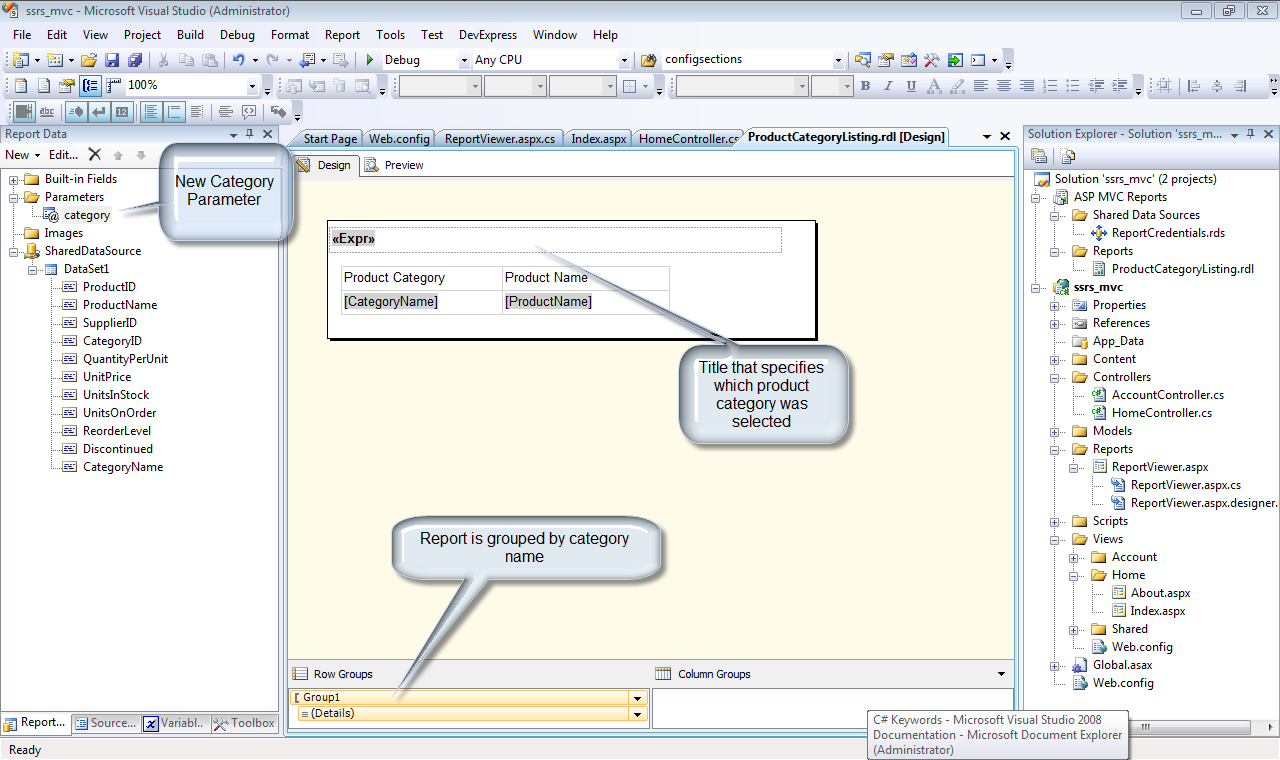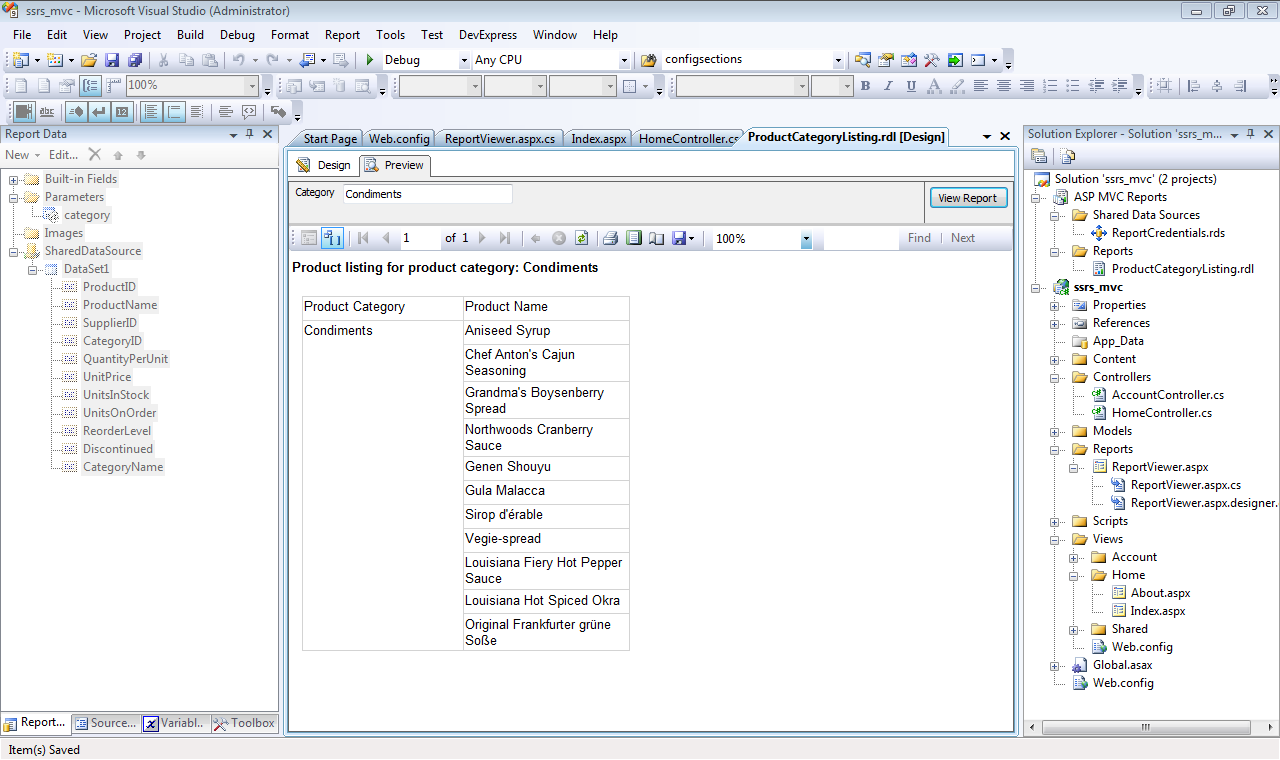Incorporating ASP.NET MVC and SQL Server Reporting Services, Part 2
In the last issue, I introduced you to the basics of incorporating SQL Server Reporting Services into your ASP.NET MVC applications. In this issue, I’ll finish the series by illustrating how we can transfer data between the ASP.NET MVC context and the SSRS report context. In addition, I will also cover deployment issues such as authentication.
To illustrate these additional concepts, I will use our trusty old friend, the Northwind database. In particular, the report will leverage the Alphabetical List of Products view.Figure 1 illustrates the design time view of our report. The report has one parameter - category. Ultimately, this parameter will be supplied by the ASP.NET MVC application.Figure 2 illustrates the report in preview mode, listing products in the condiment category. In part 1 of this article I covered how to build and deploy reports to the report server. If you need to primer on those concepts, please consult that previous article.
 Figure 1: The report in this example is a listing of products, sorted by category.
Figure 1: The report in this example is a listing of products, sorted by category. Figure 2: Product listing report in preview mode.
Figure 2: Product listing report in preview mode.
Passing Data Between Contexts
Listing 1 illustrates the controller method that launches the product listing report.Figure 3 illustrates the ASP.NET MVC page that invokes the ProductListingReport action. The key to passing data between contexts lies in the Session variable. The code uses a hash to keep track of report variables and their respective values. That hash is stored in the Session[“reportParameters”] variable. In part 1 of this article, the process was very specific in regards to the generated report. In fact, the Web Form that hosts the report viewer control could run any report. In other words, the report viewer controller only needs to know the report server and the report name. Accordingly, the report server and report name details will be passed to the report viewer control. With these examples we very easily achieve reusability. The last line of code re-directs the application to the report viewer aspx page. Listing 2 illustrates how the report viewer acts on these passed values.
In Listing 2, there are four basic operations:

- Report server specification
- Report name specification
- Security credentials specification
- Report parameter setting
You may be wondering where the report server and security credential information is stored. Because the report server and security credentials are not specific to any one report, that data should not be specified in a controller. Rather, these data points belong as part of the application configuration. In the case of an ASP.NET application, those configuration items are stored in the web.config file. The following configuration items supply the needed data:
<appSettings><add key="ReportServerURL"value="http://host/reportserver" /><add key ="ReportServerDomain" value="Domain"/><add key ="ReportServerUser" value="User"/><add key="ReportServerPassword"value="Password"/></appSettings>
The domain, user and password data listed is for illustration purposes only. In a real production scenario, the report server will exist on a separate server that has its own authentication requirements. In order gain access to and to run those reports, authentication credentials must be passed to the report viewer.
Generating the Report
Because the ASP.NET MVC app will supply the necessary parameter values, there is no need to make parameters accessible or visible within the report. Figure 4 illustrates the report as generated by the ASP.NET MVC application. The following snippet shows the SQL code used by the report. The code incorporates the @category parameter. That is how the results are filtered.
SELECT *FROM[Northwind].[dbo].[Alphabetical list of products]where CategoryName like @category
Conclusion
The combination of ASP.NET MVC and SQL Server Reporting Services (SSRS) provide a framework for robust applications. In this two-part series, you have seen how easy it is to extend your ASP.NET MVC applications with SSRS. With the approach presented here, you can easily achieve reusability, thereby using a common set of application components that are not specific to any one report and/or report server. I hope you find the information presented over these past two issues to be useful in your application development efforts. Until next time - happy coding!
- Listing 1: Controller method to launch report
- [HttpPost]
- public ActionResult ProductListingReport(FormCollection form)
- {
- var reportParameters =
- new Dictionary<string, string>();
- if (form["Category"] == "All")
- form["Category"] = "%";
- reportParameters.Add("category",
- form["Category"]);
- Session["reportParameters"] =
- reportParameters;
- Session["reportPath"] =
- "/ASPMVCReports/ProductCategoryListing";
- return
- Redirect("../Reports/ReportViewer.aspx");
- }
- Listing 2: Page_Load code for ReportViewer.aspx page
- protected void Page_Load(object sender, EventArgs e)
- {
- if (!Page.IsPostBack)
- {
- //Specify the report server
- ReportViewer1.
- ServerReport.
- ReportServerUrl =
- new Uri(WebConfigurationManager.
- AppSettings["ReportServerURL"]);
- //Specify the report name
- ReportViewer1.
- ServerReport.
- ReportPath = Session["reportPath"].ToString();
- //Specify the server credentials
- ReportViewer1.
- ServerReport.
- ReportServerCredentials =
- new CustomReportCredentials
- (
- WebConfigurationManager.
- AppSettings["ReportServerUser"],
- WebConfigurationManager.
- AppSettings["ReportServerPassword"],
- WebConfigurationManager.
- AppSettings["ReportServerDomain"]
- );
- /*
- * With the report specified, hydrate the report
- * parameters based on the values in the
- * reportParameters hash.
- */
- var reportParameters = (Dictionary<string,
- string>)Session["reportParameters"];
- foreach (var item in reportParameters)
- {
- ReportViewer1.
- ServerReport.
- SetParameters(
- new List<ReportParameter>()
- {
- new ReportParameter
- (item.Key, item.Value)
- });
- }
- }
- }
Incorporating ASP.NET MVC and SQL Server Reporting Services, Part 2的更多相关文章
- Incorporating ASP.NET MVC and SQL Server Reporting Services, Part 1
Your ASP.NET MVC application needs reports. What do you do? In this article, I will demonstrate how ...
- ASP.NET MVC与Sql Server交互,把字典数据插入数据库
在"ASP.NET MVC与Sql Server交互, 插入数据"中,在Controller中拼接sql语句.比如: _db.InsertData("insert int ...
- ASP.NET MVC与Sql Server交互, 插入数据
在"ASP.NET MVC与Sql Server建立连接"中,与Sql Server建立了连接.本篇实践向Sql Server中插入数据. 在数据库帮助类中增加插入数据的方法. p ...
- [转]SQL Server Reporting Services - Timeout Settings
本文转自:https://social.technet.microsoft.com/wiki/contents/articles/23508.sql-server-reporting-services ...
- SQL Server Reporting Services本机模式下的权限管理
SQL Server Reporting Services在安装配置后,缺省只给BUILTIN\Administrators用户组(实际上只有本机的Administrator用户)提供管理权限.所以所 ...
- SrsDataConnector The SQL Server Reporting Services account is a local user and is not supported.
这次使用OS+SQL的镜像还原系统后安装了CRM 2015,主要流程是 安装IIS/AD,SSRS ,CRM2015.自带的SQL中SSRS没有安装完全,需配置一下. 这一切都满顺利的,最后在安装 S ...
- 充分利用 SQL Server Reporting Services 图表
最近在查SSRS的一些文章,看到MSDN在有一篇不错的文章,许多图表设置都有说明,共享给大家.. 其中有说明在SSRS中如果去写条件表达写和报表属性中的“自定义代码”,文章相对比较长,需要大家耐心的查 ...
- SQL Server Reporting Services – Insufficient Rights Error
http://www.sql-server-performance.com/2011/security-ssrs-reporting-error/ SQL Server Reporting Servi ...
- SQL Server Reporting Services (SQLEXPRESS) 服务占用80端口
win7, 好多时候,看到system进程占用了80端口,这个是系统进程,不能直接结束.我们不知道这个进程的哪个服务占用了80端口,这里记录其中一个服务"SQL Server Reporti ...
随机推荐
- springmvc 读写分离
推荐第四种:https://github.com/shawntime/shawn-rwdb 4种不方的读写分离实现方法 http://blog.csdn.net/lixiucheng005/artic ...
- 阿里云ipv6安全组匹配所有ip的方法
IPv4和IPv6通信彼此独立.您需要为ECS实例单独配置IPv6安全组规则. 操作步骤 登录ECS控制台. 在左侧导航栏,单击网络和安全 > 安全组. 找到目标安全组,然后单击配置规则. 单击 ...
- robot framework :List Variables-List变量及其用法
[转自:https://blog.csdn.net/yezibang/article/details/52692342] 这一讲我们重点来介绍List Variables-List变量及其用法. 一. ...
- Jenkins---简单认识
老生常谈:知其然更要知其所以然,所以补充一下Jenkins的相关知识 官方文档:https://jenkins.io/zh/doc/ 问题1:Jenkins是什么? 1.1.Jenkins是一个开源的 ...
- 应用安全-软件安全-漏洞CVE整理
jira ssrf CVE-2019-8451 url = url + '/plugins/servlet/gadgets/makeRequest?url=' + host + '@www.baidu ...
- C#建造者模式
/// <summary> /// 电脑类 /// </summary> public class Computer { //电脑组件集合 private IList<s ...
- oracle--约束(主键、非空、检查)
问题1:学号重复了,数据还可以插入成功 使用主键约束:学号是唯一标识一条数据的,所以必须唯一且不能为空 ---(1).在确定为主键的字段后添加 primary key关键字 ---(2).在创建表的后 ...
- CentOS6 破解登录密码
1.重启服务器,在倒数读秒的时候按任意键,就会出现如下界面 2.按e进入grub模式,选中kernel,然后按e进入内核编辑模式 3.进入内核编辑模式后,按空格+1回车(或按空格+single回车)退 ...
- css中的居中的方法
一.垂直居中 (1)inline或者inline-*元素 1. 单行文字 设置上下padding相等 以前一直以为inline元素是没有上下的padding和margin的,其实不然,他们是有上下的p ...
- (二:NIO系列) Java NIO Buffer
出处:Java NIO Buffer Buffer是一个抽象类,位于java.nio包中,主要用作缓冲区.Buffer缓冲区本质上是一块可以写入数据,然后可以从中读取数据的内存.这块内存被包装成NIO ...
